new posts in all blogs
Viewing: Blog Posts Tagged with: melba liston, Most Recent at Top [Help]
Results 1 - 5 of 5
How to use this Page
You are viewing the most recent posts tagged with the words: melba liston in the JacketFlap blog reader. What is a tag? Think of a tag as a keyword or category label. Tags can both help you find posts on JacketFlap.com as well as provide an easy way for you to "remember" and classify posts for later recall. Try adding a tag yourself by clicking "Add a tag" below a post's header. Scroll down through the list of Recent Posts in the left column and click on a post title that sounds interesting. You can view all posts from a specific blog by clicking the Blog name in the right column, or you can click a 'More Posts from this Blog' link in any individual post.

By:
rgarcia406,
on 4/28/2016
Blog:
The Open Book
(
Login to Add to MyJacketFlap)
JacketFlap tags:
Jazz,
Dear Readers,
Frank Morrison,
African American interest,
Lee & Low Likes,
International Jazz Day,
Book Lists by Topic,
melba liston,
children's books,
diversity,
Add a tag
Music transcends language and culture, letting its listeners be united by something beyond words. That is why UNESCO (United Nations Educational, Scientific and Cultural Organization) designated April 30th to be International Jazz Day. This day serves to highlight jazz’s “diplomatic role in uniting people in all corners of the globe.”
Celebrate International Jazz Day with these seven books about Jazz from LEE & LOW BOOKS:

Rent Party Jazz, written by William Miller and illustrated by Charlotte Riley-Webb – Sonny Comeaux has to work in order to help his mother make ends meet. Mama loses her job, and Sonny is worried: How will they make the rent? A jazz musician named Smilin’ Jack helps Sonny have the world’s best party, and raise the rent money i n the process. Buy here.
n the process. Buy here.
i see the rhythm, written by Toyomi Igus and illustrated by Michele Wood – This book is a visual and poetic introduction to the history of African American music, including Jazz music. Buy here.
Jazz Baby, written by Carole Boston and illustrated by Laura Freeman – This book is a celebration of music and movement. This story in verse is inspired by the riffs, rhythms, and freedom of jazz. Buy here.
Little Melba and Her Big Trombone, written by Katheryn Russell-Brown and illustrated by Frank Morrison – This award-winning biography follows the life of legendary jazz trombonist, composer, and arranger Melba Liston. At the age of 7, Melba fell in love with the trombone. Later, she broke racial and gender barriers tobecome a famed trombone player and arranger, spinning rhythms, harmonies, and melodies into gorgeous songs for all the jazz greats of the twentieth century: Randy Weston, Duke Ellington, Count Basie, Billie Holiday, and Quincy Jones, to name just a few. Buy here.
the trombone. Later, she broke racial and gender barriers tobecome a famed trombone player and arranger, spinning rhythms, harmonies, and melodies into gorgeous songs for all the jazz greats of the twentieth century: Randy Weston, Duke Ellington, Count Basie, Billie Holiday, and Quincy Jones, to name just a few. Buy here.
Sweet Music in Harlem, written by Debbie Taylor and illustrated by Frank Morrison – C.J. needs to act fast. A photographer from Highnote magazine is on his way to take a picture of his Uncle Click, a well-known jazz musician. But Uncle Click’s signature hat is missing! C.J. must find it before the photo shoot. Buy here.
Rainbow Joe and Me, by Maria Diaz Strom – Eloise likes colors and so does her friend,  Rainbow Joe. Since Rainbow Joe is blind, Eloise tells him about the colors she mixes and the fantastic animals she paints. Rainbow Joe tells Eloise that he can also mix and paint colors. Buy here.
Rainbow Joe. Since Rainbow Joe is blind, Eloise tells him about the colors she mixes and the fantastic animals she paints. Rainbow Joe tells Eloise that he can also mix and paint colors. Buy here.
Ray Charles, written by Sharon Bell Mathis and illustrated by George Ford – This award-winning biography follows the life of world-renowned jazz and blues musician Ray Charles. It includes a new introduction by author Sharon Bell Mathis and updates his life to the present day. Buy here.
Purchase the collection here.
Further Reading:
The Little Melba Playlist: A Jazz Music Primer from Frank Morrison
Celebrate Music in Our Schools Month with Drum-Inspired Books
Interview: Katheryn Russell-Brown on the research behind Little Melba and Her Big Trombone
Illustrator Frank Morrison takes us behind the art of Little Melba and Her Big Trombone
Book and Activity Suggestions to Match Your Summer Adventure: Outdoor Concerts!
Video Thursday: Happy Birthday, Ray Charles
More Resources:
Jazz Up Writing Workshop: Writing Biographies of African American Jazz Musicians
About International Jazz Day
Bonus:
Melba Liston playing with Quincy Jones’s band in Switzerland
Ray Charles playing “America the Beautiful”

By:
rgarcia406,
on 2/11/2016
Blog:
The Open Book
(
Login to Add to MyJacketFlap)
JacketFlap tags:
Lee & Low Likes,
Diversity, Race, and Representation,
Book Lists by Topic,
melba liston,
Ira Aldridge,
Clayton Peg Leg Bates,
Teen interest,
children's books,
Diversity,
book lists,
black history month,
book collection,
Black History,
African American history,
African/African American Interest,
Frederick Douglas,
Bob Marley,
Dear Readers,
African American History Month,
Add a tag
February is Black History Month. The origins of Black History Month began with historian Carter G. Woodson launching Negro History Week in 1926. Woodson felt that teaching African American history was essential for the survival of the African American race.
In 1969, students at Kent State University proposed expanding Black History Week to Black History Month. The first Black History Month was celebrated a year later. In 1976, Black History Month was recognized by the federal government and has been celebrated ever since.
Today, heritage months can be a double-edged sword. On one hand, relegating culturally diverse books to specific months of the year can mean these books are overlooked the rest of the year. It can also separate Black history from American history, when in fact black history is American history.
On the other hand, we are still working to undo a long history in which the achievements and contributions of people of color were routinely ignored. Having a special time of year to highlight these achievements can help fill in the gaps in our history.
Our opinion? Black History Month isn’t a time for once-a-year books; the books you use this month should be in your regular rotation. But Black History Month is a good time to give your collection of African American titles a little extra love–or updating, if it needs it.
LEE & LOW is proud to offer a number of different Black History Month collections. Check them out below:
 Black History Month Collection, Grades K-2
Black History Month Collection, Grades K-2
This paperback collection features a mix of historical fiction and biographies from African Americans who excelled in arts and politics for young readers.
Featured Books:
Love Twelve Miles Long, written by Glenda Armand and illustrated by Colin Bootman – Frederick Douglass’s mother travels twelve miles late at night to visit him in another plantation. Mama recounts why every step of the way is special to her.
Knockin’ On Wood, by Lynne Barasch – Clayton “Peg Leg” Bates, a legendary 20th century tap dancer, lost his leg in an accident at the age of twelve. He taught himself how to dance, first with crutches and then later with a peg leg.
Purchase this collection here

Black History Month Collection, Grades 3-6
This collection explores the lives of great African Americans with a wide range of picture book biographies and historical fiction books for young readers.
Featured Books:
Little Melba and Her Big Trombone, written by Katheryn Russell-Brown and illustrated byFrank Morrison – This award-winning biography follows the life of Melba Liston, a trailblazing musician and a great unsung hero of jazz.
Ira’s Shakespeare Dream, written by Glenda Armand and illustrated by Floyd Cooper -Ira Aldridge dreamed of being on stage one day performing the great works of William Shakespeare. Due to little opportunity in the United States, Ira journeyed to Europe and through perseverance and determination became one of the most respected Shakespearean actors of his time.
Purchase this collection here
 Black History Month Collection, Grades 7-12
Black History Month Collection, Grades 7-12
This collection is perfect for a wide range of middle to high school level readers. Readers will be able to explore the history of African American music, Civil Rights, and sports.
Featured Books:
i see the rhythm, written by Toyomi Igus and illustrated by Michele Wood – This book explores African American music throughout history, starting with its roots in Africa.
I and I Bob Marley, written by Tony Medina and illustrated by Jesse Joshua Watson – This book of poems explores the life of famous musician Bob Marley.
Purchase this collection here

Black History Month Special Collection This collection features a mix of award-winning hardcover and paperback biographies of great African Americans at a range of reading levels.
Featured Book:
Love to Langston, written by Tony Medina and illustrated by R. Gregory Christie – Fourteen original poems explore the life of Langston Hughes, one of America’s most beloved poets.
Purchase this collection here

Black History Month Paperback Collection
This collection features hand-picked award winning books, available in paperback.
Featured Book:
In Her Hands, written by Alan Schroeder and illustrated by JaeMe Bereal – Augusta Savage enjoyed sculpting with clay, despite her stern father thinking it was a waste of her time. To pursue a career as an artist, Augusta leaves everything she knows behind and journeys to New York.
Further Reading:
Who Is Ira Aldridge?
Remembering Cortez Peters
Why Remember Bill Traylor?
Why Remember Florence “Baby Flo” Mills?
Why Remember Author Ashe?
Why Remember Robert Smalls?
Why Remember Toni Stone?
Storyline Online: Catching the Moon
Seven Core Values to Celebrate During Black History Month
Why You Should See Selma
Katheryn Russell-Brown on the Research Behind Little Melba and Her Big Trombone
Protesting Injustice Then and Now
Resources for Teaching About Wangari Maathai and Seeds of Change
Three Ways to Teach Etched in Clay
The Origins of the Coretta Scott King Award
More Resources
Twelve Months of Books
The Problem with Ethnic Heritage Months
African American History Month (Library of Congress)

By:
rgarcia406,
on 1/6/2015
Blog:
The Open Book
(
Login to Add to MyJacketFlap)
JacketFlap tags:
children's books,
History,
diversity,
writing,
African/African American Interest,
Race issues,
Lee & Low Likes,
Diversity, Race, and Representation,
Interviews with Authors and Illustrators,
melba liston,
Katheryn Russell-Brown,
Little Melba and her Big Trombone,
Add a tag
 Released in September of 2014, Little Melba and Her Big Trombone is the story of Melba Liston, a little-known but trailblazing musician who broke gender and racial barriers to become a famed trombonist and arranger. We interviewed author Katheryn Russell-Brown to get a better sense of the research that went into writing the book.
Released in September of 2014, Little Melba and Her Big Trombone is the story of Melba Liston, a little-known but trailblazing musician who broke gender and racial barriers to become a famed trombonist and arranger. We interviewed author Katheryn Russell-Brown to get a better sense of the research that went into writing the book.
Were you able to talk to any of Melba’s friends or family when doing research for the book? If so, what was that like?
Katheryn Russell-Brown: Yes indeed. I spoke with Leslie Drayton who co-led a band with Melba. Melba did not have children of her own, but she considered Leslie her “musical son.” He talked to me about Melba’s personality, how she carried herself and some expressions she used. I still keep in touch with him.
What jazz music did you listen to while working on this story?
KRB: Melba recorded only one lead album, “Melba Liston and Her ‘Bones” (1958). I listened to it many, many times while writing and revising Little Melba.
What aspects of Melba’s story inspired you to write this story for children?
KRB: The more I read and learned about Melba Liston, the more impressed I was with her talent. By every account she was a phenomenal arranger and a master trombone player.
Melba’s mother and grandfather play a large role in encouraging Melba’s trombone playing. What word of advice would you give to parents to encourage their children’s talents or interests?
KRB: What I love is that Melba’s mother, Lucille Liston, followed Melba’s lead even though she wasn’t thrilled with Melba’s choice of instrument. She thought the trombone was too big and that it wasn’t for girls! However, at Melba’s urging, her mother bought the trombone and supported her throughout her career.
What aspect of Melba’s story do you think is especially relevant for young people today?
KRB: Try to find something you love to do and do your best with it.
What’s one fact about Melba you learned that didn’t make it to the book?
KRB: Melba appeared in two major motion pictures. In “The Prodigal” (1955), Liston played the harp and appeared in scenes with Lana Turner. She was also a member of the palace orchestra in “The Ten Commandments” (1956).
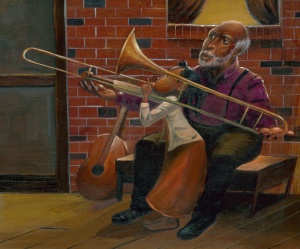 How difficult is it to play the trombone?
How difficult is it to play the trombone?
KRB: As I write in Little Melba, “the trombone was no piece of cake.” First, holding it properly is a challenge. Second, it’s heavy, long, and bulky. Third, you have to purse your lips just right, move the slide, and blow!
Even though Melba quits playing the trombone for a while, she eventually returns to it. What would you say to young people that are thinking of quitting something they enjoy doing or are good at?
KRB: If you’re going to quit, quit for the right reasons! Don’t quit because something is hard or challenging. If, however, something that brought you joy is no longer bringing joy, it’s OK to take a break.
Melba loved music and really loved the trombone. However, being on the road was tough for her—times could be tough and sometimes she felt lonely. After going on tour with jazz singer Billie Holiday, Melba decided to take a break. She got a job as a clerk for the Los Angeles Board of Education. She was lured back to music when Dizzy Gillespie asked her to re-join his orchestra and travel to South America.
In addition to your work as a children’s book writer, you are also a Professor of Law and Director of the Center for Race and Race Relations at the University of Florida. How do you think your work as a professor informed the way you decided to tell Melba’s story?
KRB:It certainly did inform my approach to writing Little Melba. I love doing research and I love writing, re-rewriting, and editing.
Filed under:
Diversity, Race, and Representation,
Interviews with Authors and Illustrators,
Lee & Low Likes Tagged:
African/African American Interest,
children's books,
diversity,
History,
Katheryn Russell-Brown,
Little Melba and her Big Trombone,
melba liston,
Race issues,
writing 


By:
rgarcia406,
on 11/7/2014
Blog:
The Open Book
(
Login to Add to MyJacketFlap)
JacketFlap tags:
illustration,
Book News,
diversity,
art,
illustrations,
New Releases,
Cover Design,
African/African American Interest,
Dear Readers,
Frank Morrison,
jazz music,
Lee & Low Likes,
Art and Book Design,
Interviews with Authors and Illustrators,
melba liston,
Katheryn Russell-Brown,
Little Melba,
Little Melba and her Big Trombone,
Add a tag
 Released in September, Little Melba and her Big Trombone, is the story of Melba Liston, a little-known but trailblazing jazz musician who broke racial and gender barriers to become a famed trombonist and arranger. We asked illustrator Frank Morrison to take us behind the scenes for creating the art work used in Little Melba and her Big Trombone.
Released in September, Little Melba and her Big Trombone, is the story of Melba Liston, a little-known but trailblazing jazz musician who broke racial and gender barriers to become a famed trombonist and arranger. We asked illustrator Frank Morrison to take us behind the scenes for creating the art work used in Little Melba and her Big Trombone.
Illustration Process
- After reading the manuscript for Little Melba and her Big Trombone, I immediately searched for references that could help me bring the story to life. This included clothing from the time period and a trombone, which I have never painted before. I was fortunate enough to find a CD by Melba titled, “Melba Liston and her Bones” as well. After gathering all of my materials my studio begins to sound like a jazz session as I begin reading.
- I make thumbnails sketches and jot down notes on the sides of the manuscript while the Be Bopping is blaring from the speakers. My sketches are loose like a trombone’s slide and they take about a minute each.
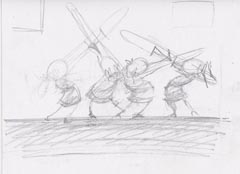
- When the thumbnails are completed I being drawing defined sketches from them and at the same time placing them in page order. Sometimes I may have two or three different ideas for a page as shown in the cover sketches.
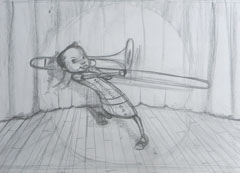
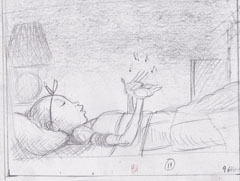
- Once my sketches are approved, I transfer the final drawings to an illustration board. This, of course, is done after I’ve measuring the dimensions and taped off the edges, which includes a half-inch border.
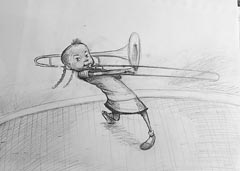
- I spray a fixative on the drawing so it won’t smudge then coat it with a clear gesso. Next I tape the image to a wooden board. The board allows me to work sitting down at my art table or placing the painting on my easel.
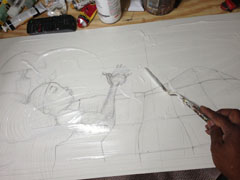
- Finally I use a lot of jazz music, dancing and oil paints to finish the final art.
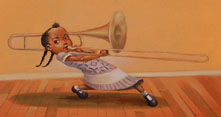
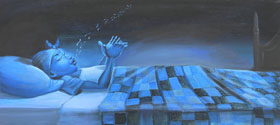
Filed under:
Art and Book Design,
Book News,
Cover Design,
Dear Readers,
Interviews with Authors and Illustrators,
Lee & Low Likes,
New Releases Tagged:
African/African American Interest,
art,
diversity,
Frank Morrison,
illustration,
illustrations,
jazz music,
Katheryn Russell-Brown,
Little Melba,
Little Melba and her Big Trombone,
melba liston 


By:
keilinh,
on 9/17/2014
Blog:
The Open Book
(
Login to Add to MyJacketFlap)
JacketFlap tags:
Music,
louis armstrong,
musical instruments,
Duke Ellington,
Musings & Ponderings,
dizzy gillespie,
miles davis,
Frank Morrison,
jazz music,
Lee & Low Likes,
Art and Book Design,
jazz videos,
melba liston,
trombones,
Add a tag
Summer is coming to an end, but that doesn’t mean the fun stops! With cooler weather comes fun indoor activities, like catching a great jazz show. We asked Frank Morrison, illustrator of our new picture book biography, Little Melba and Her Big Trombone, to share some of his favorite jazz numbers with us. Many of the artists below played or arranged with Melba Doretta Liston; others inspired Frank while he created his illustrations. So sit back with your cup of apple cider and let the rhythm carry you away!
- John Coltrane: “Out of This World,” plus Coltrane’s albums The Inch Worm, Big Nick, and Giant Steps
- Thelonious Monk: “Well, You Needn’t,” “Ruby, My Dear,” “Off Minor,” and “Bemsha Swing”
- Dizzy Gillespie: “52nd Street Theme” and “A Night in Tunisia”
- Miles Davis: “Freddie Freeloader,” “Round Midnight,” “Airegin,” and “Blue in Green,” plus Davis’s album Kind of Blue
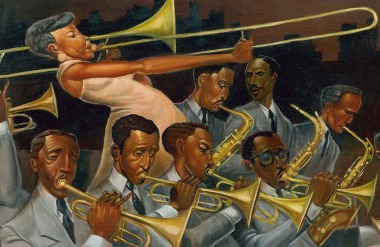
- Chet Baker: “My Funny Valentine”
- Art Blakey: “Dat Dere,” “Moanin’,” “Blues March,” “The Chess Players,” and “Señor Blues” (performed with Horace Silver)
- Abbey Lincoln: “Afro Blue”
- Clifford Brown: “Daahoud,” “The Blues Walk,” “Jordu,” and “Parisian Thoroughfare”
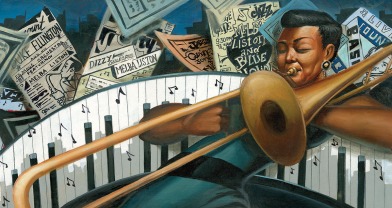
- Duke Ellington: “In a Sentimental Mood” and “Take the ‘A’ Train”
- Stan Getz: “Corcovado” and “I’ve Got You Under My Skin”
- Louis Armstrong: “Summer Song,” “West End Blues,” and “I Got Rhythm”
Still can’t get enough jazz music? Here’s Duke Ellington’s “In a Sentimental Mood.”
Have your own favorite jazz tunes? Leave ‘em in the comments!
Filed under:
Art and Book Design,
Lee & Low Likes,
Musings & Ponderings Tagged:
dizzy gillespie,
Duke Ellington,
Frank Morrison,
jazz music,
jazz videos,
louis armstrong,
melba liston,
miles davis,
Music,
musical instruments,
trombones 

 n the process. Buy here.
n the process. Buy here. the trombone. Later, she broke racial and gender barriers tobecome a famed trombone player and arranger, spinning rhythms, harmonies, and melodies into gorgeous songs for all the jazz greats of the twentieth century: Randy Weston, Duke Ellington, Count Basie, Billie Holiday, and Quincy Jones, to name just a few. Buy here.
the trombone. Later, she broke racial and gender barriers tobecome a famed trombone player and arranger, spinning rhythms, harmonies, and melodies into gorgeous songs for all the jazz greats of the twentieth century: Randy Weston, Duke Ellington, Count Basie, Billie Holiday, and Quincy Jones, to name just a few. Buy here. Rainbow Joe. Since Rainbow Joe is blind, Eloise tells him about the colors she mixes and the fantastic animals she paints. Rainbow Joe tells Eloise that he can also mix and paint colors. Buy here.
Rainbow Joe. Since Rainbow Joe is blind, Eloise tells him about the colors she mixes and the fantastic animals she paints. Rainbow Joe tells Eloise that he can also mix and paint colors. Buy here.




















Love this interview! Going now to find out more about the book and author! Thanks.